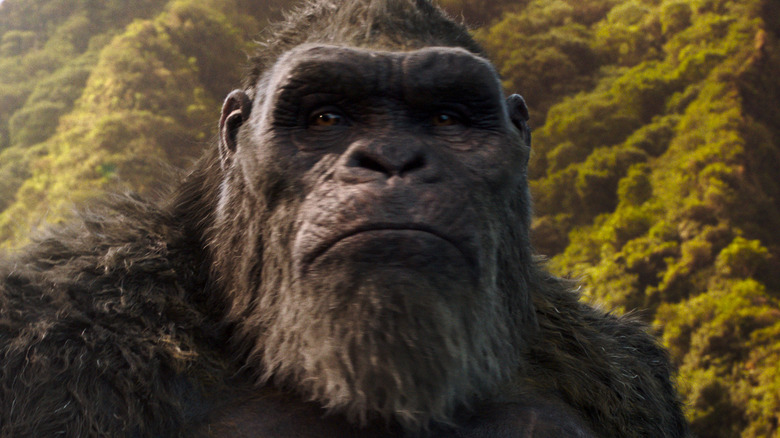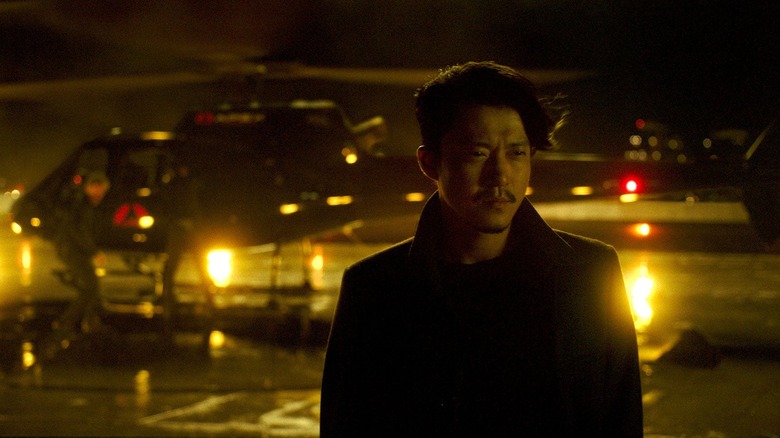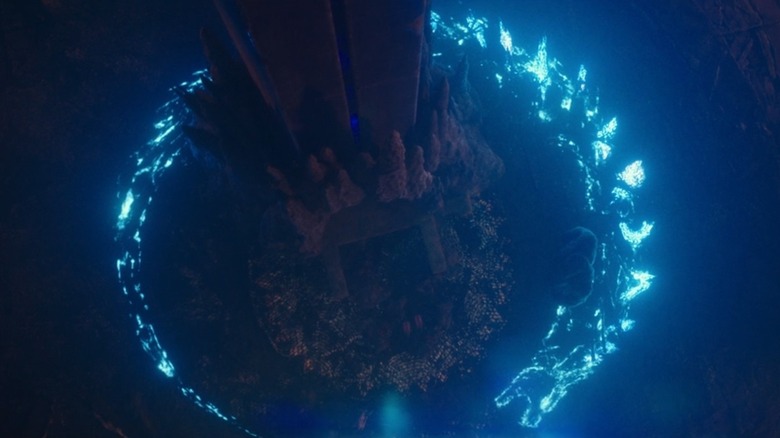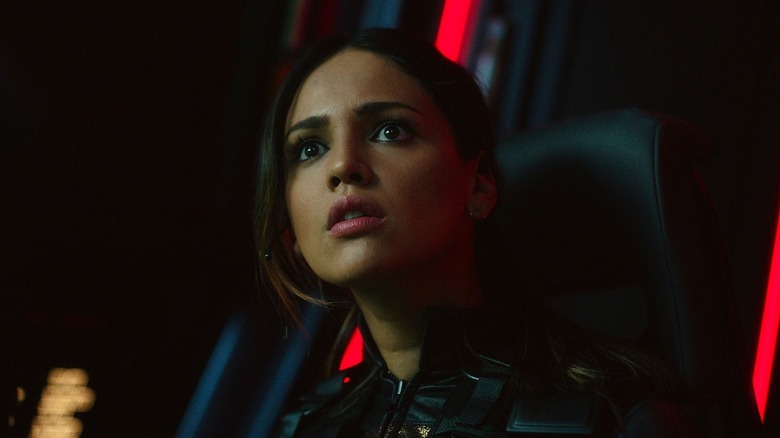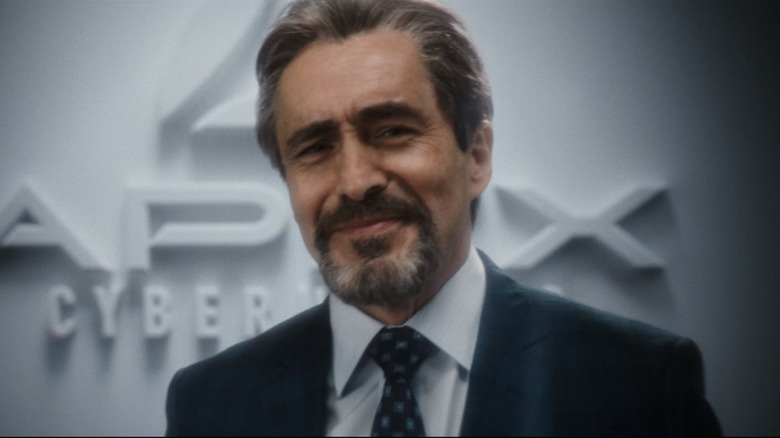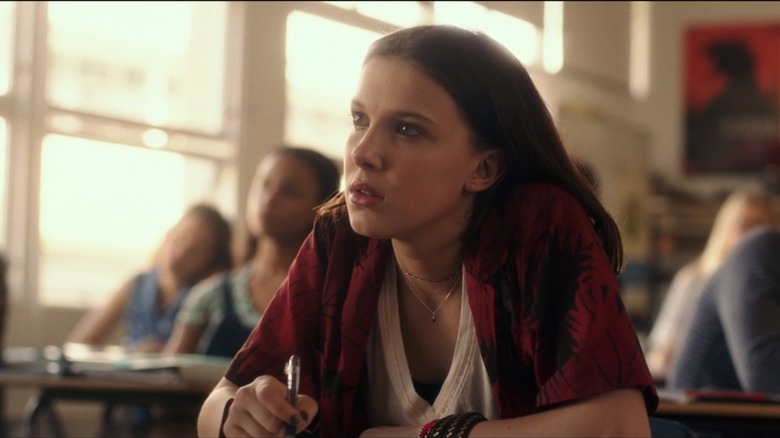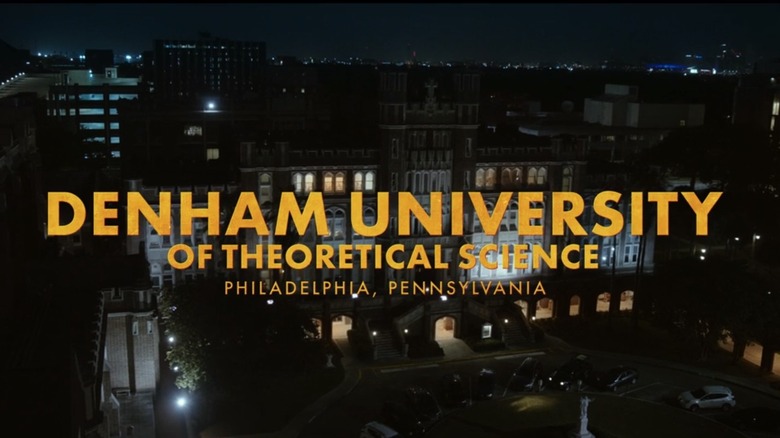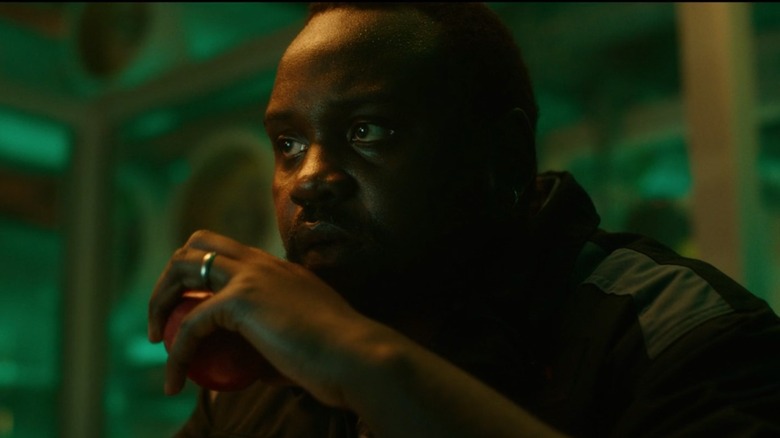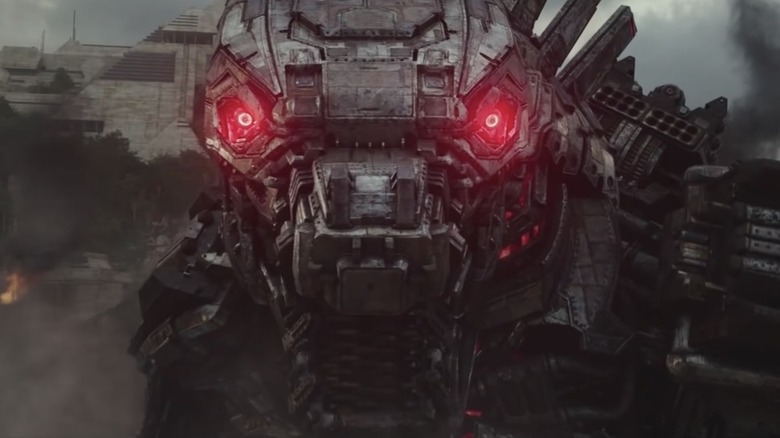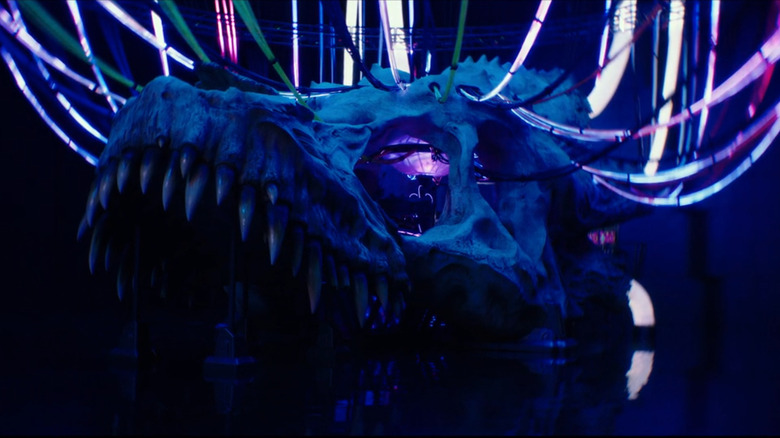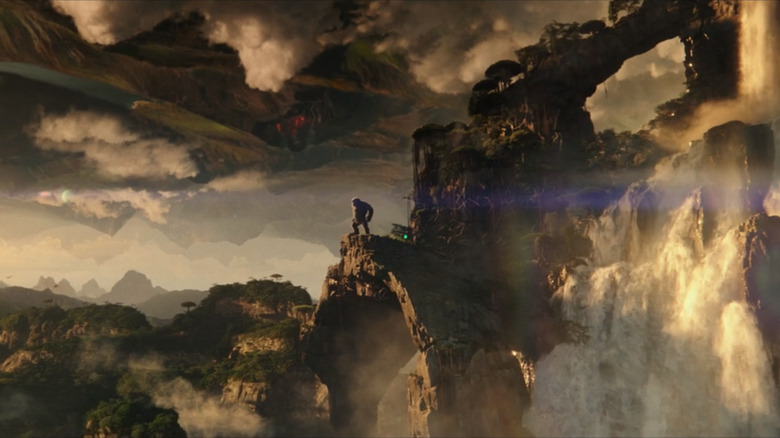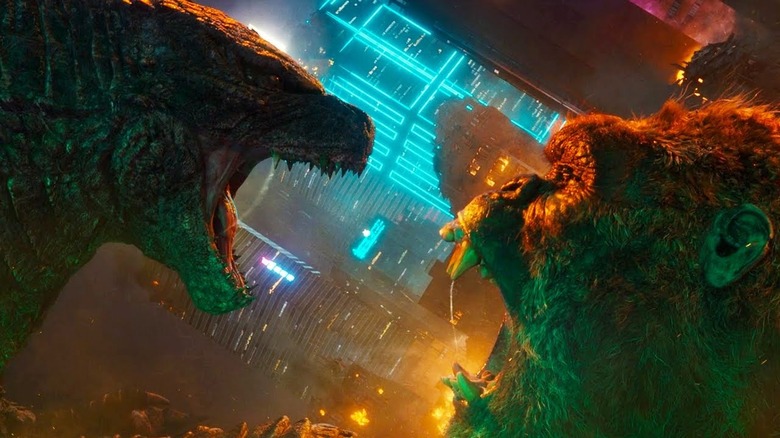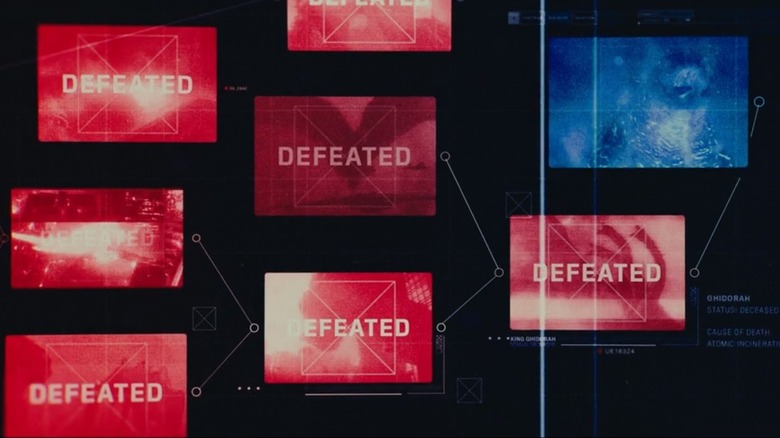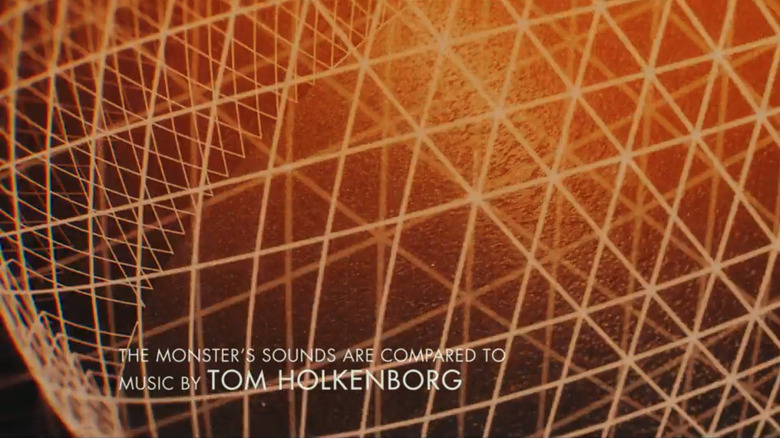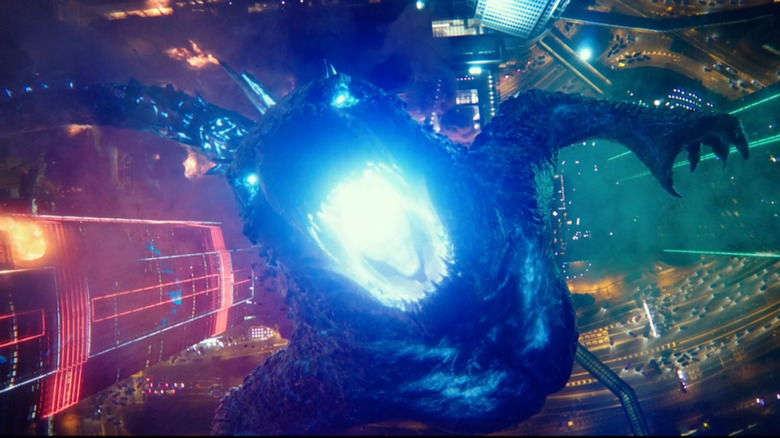Things You Only Notice In Godzilla Vs. Kong A Second Time
After a few delays, "Godzilla vs. Kong" was simultaneously released to theaters and on HBO Max in early 2021. The film is the fourth in Legendary Pictures' MonsterVerse, which also contains 2014's "Godzilla," 2017's "Kong: Skull Island," and 2019's "Godzilla: King of the Monsters." Millie Bobby Brown's Madison Russell from the latter film returns, while newcomers include Rebecca Hall as Dr. Ilene Andrews, Alexander Skarsgård as Dr. Nathan Lind, Demián Bichir as Walter Simmons, Brian Tyree Henry as Bernie, Julian Dennison as Josh, and Deaf actress Kaylee Hottle as Jia, a young Iwi who has a special bond with Kong.
In "Godzilla vs. Kong," Godzilla and the Titans haven't been seen in several years. The movie interweaves three plotlines that culminate in one epic battle in Hong Kong. Madison, Josh, and Bernie investigate what Simmons is doing at his company, Apex Cybernetics, while Andrews raises Jia and monitors Kong for Monarch. Meanwhile, Lind needs to prove the existence of Hollow Earth. The three plotlines intersect after Godzilla attacks an Apex facility. Simmons asks Lind to find Hollow Earth and Lind, in turn, asks Andrews if he can borrow Kong for his mission. It doesn't take long before Kong and Godzilla brawl.
With so much going on, it's easy to miss a lot of subtle and not-so-subtle bits in the background. Here's a list of things you only notice when you see "Godzilla vs. Kong" a second time. There are several major spoilers below, so proceed with caution if you're spoiler-averse!
Ren Serizawa is Dr. Ishirō Serizawa's son
In one brief moment, Walter Simmons introduces his scientist/engineer as Ren Serizawa ... and then the surname of Shun Oguri's character is glossed over. Considering Dr. Ishirō Serizawa is one of the main protagonists in 2014's "Godzilla" and 2019's "Godzilla: King of the Monsters," you might assume a younger character with the same surname would be related — and you'd be right! Ren is Ishirō's son. So why isn't a major connection to the previous two movies given more heft?
In a word: time. According to director Adam Wingard in a Reddit AMA, Ren being Ishirō's son was intentionally cut. "Just didn't have the time in the plot to get more into it," he said, adding that he felt it was "interesting leaving it mysterious." It's unfortunate Ren's background isn't in the film, though it's explained in the novelization. Exploring his relationship with his father onscreen could have illuminated his obvious anger toward Godzilla. Perhaps he wants revenge on Godzilla for his father's absence in his life? Maybe being a Serizawa explains how he can make the psychic uplink with Mechagodzilla? Also, Ren using technology to get back at the monster saved by his father's scientific sacrifice is thematically rich material that would have been great to see.
Oguri's scenes weren't the only ones cut for time and plot considerations. Wingard told Total Film that Lance Reddick's role was severely reduced, and both Zhang Ziyi, who played twins Dr. Chen and Dr. Ling in "Godzilla: King of the Monsters," and franchise newcomer Jessica Henwick were cut completely.
The discovery of Kong's axe foreshadows its use later
Once Kong "agrees" to go down into Hollow Earth in search of others like himself, it's only a matter of time before he finds what he's looking for: evidence of his kind's reign, such as a throne large enough for a giant ape to sit on. But his biggest discovery is the giant axe he finds embedded in the skull of a lizard-like creature. Who made it? And why does the blade look so familiar?
Primates using tools is a real-world phenomenon, so Kong's ancestors making a battle axe is not just a pure flight of fantasy. Of course, the blade being a Godzillasaurus dorsal fin is. As Max Borenstein tells Collider, "Godzilla's scales have sort of a conductive, radioactive quality," adding that Kong's ancestors "used the spine of a Godzilla-creature to create" the axe because it's ideal for them to fashion into a weapon against their enemy. "It feels like the iconic scepter of a king," Borenstein says.
Also, when Kong sees an axe-shaped indentation in the floor, he places the axe on it, which powers up the axe and lights up a glyph of Godzilla. Both the cracked skull and the axe's illumination foreshadow that not only will Kong use it to fight Godzilla, but that it will play a bigger part in the battle to come with Mechagodzilla, when Godzilla focuses his atomic breath into the blade to super-charge the weapon. That extra power, along with a little help from Madison and her friends, enables Kong to defeat the mecha terror.
Maia Simmons gives away her villainy early on
Something seems off about Walter Simmons and his offer to fund Nathan Lind's expedition to Hollow Earth. Lind, who's still grieving his brother's death, doesn't seem to notice that Simmons is smarmy and a bit insincere. It's no wonder, then, that Simmons' daughter Maia turns out to be a straight-up villain.
Eiza González plays Maia as laser-focused on reaching Hollow Earth and smug about her father's technology. She's arrogant and determined to get what she wants — which turns out to be a power source Walter can use to power Mechagodzilla and destroy all Titans.
She's also dismissive of everyone else and treats Kong, the film's hero, especially poorly. All of this could be chalked up to a personality flaw except for one thing: Maia regards Kong as an object. She uses one word over and over that codes her instantly as a villain — she derogatorily refers to Kong, an ape, as a monkey. She even tells Lind and Andrews to "dump the monkey" when Godzilla attacks them. She can't be bothered to refer to Kong by name either, and she clearly only cares about herself and her mission. She won't give Kong respect, but she demands it for herself when Lind refers to her father's Hollow Earth Aerial Vehicles, or H.E.A.V.s, as helicopters. She's so bad that her death is even foreshadowed in the opening credits.
Walter Simmons' Apex Cybernetics video tips off what he's created
The Apex Cybernetics video with Walter Simmons not only ties into the film's references to the "Terminator" franchise, but it also flat-out foreshadows Mechagodzilla's true nature.
"Godzilla vs. Kong" first introduces Apex via Bernie Hayes (Brian Tyree Henry), who hosts a podcast called "Titan Truth" and who has infiltrated the company as part of his quest to find out what conspiracy shenanigans they've been committing. The thing is, if he'd just watched the promotional video in the lobby, he'd know everything.
Simmons, the billionaire founder and CEO of Apex, narrates the short video, telling visitors that Apex has big dreams and that they work in three areas: robotics, the mind, and artificial intelligence. The video shows robotic arms farming, a scan of a human brain turning into a series of neural pathways with a computer chip in the middle, and a person hooked up to a computer that appears to be mapping his mind. As Bernie will discover later, Mechagodzilla is a robotic creature hooked up to a skull via neural pathways connected to a human mind — that of Ren Serizawa. Holy giving away the entire store there, Batman!
When Simmons intones at the end of the video, "Who knows what brave new future we'll dream of next?" little does anyone know at the time that the brave new future is shiny, chrome, hundreds of feet tall, and full of animosity for everyone and everything.
The evolution of Madison Russell
"Godzilla: King of the Monsters" introduced new characters into the MonsterVerse, including Madison Russell, a bright young girl whose parents were the divorced Monarch scientists, Emma and Mark. Madison lived with Emma and was exposed to her obsession with saving the planet via releasing the Titans, and also her intense grief over the loss of Andrew, Madison's brother, an unintended casualty of Godzilla's fight with the female MUTO.
Madison was torn between her parents and their ideologies, but she was also curious and, like a lot of kids, she touched everything: Mothra's nose, the ice encasing Ghidorah — whom she clarified was "Monster Zero" when he was called Ghidorah by others — and the ORCA device controlling the Titans.
In "Godzilla vs. Kong," Madison takes on the function of characters who didn't make it out of the previous film. For example, she uses the deceased Dr. Graham's terminology when she tells Mark about Godzilla's "intimidation display" at the Apex attack, and when Josh refers to Monster Zero, she clarifies the Titan's name as Ghidorah. Her advocating for Godzilla and explaining his behavior to her father, the animal behavior expert, signifies her growth into a scientist like her parents and her position in the film as Godzilla's main defender.
She also still touches everything, which comes in handy because she can instantly decode a password sequence on doors at Apex that gets her, Bernie, and Josh into the room where they discover what's really powering Mechagodzilla.
Sometimes a university is not just a school
Before Walter Simmons meets Dr. Lind, there's a quick title superimposed over a building to let the audience know Lind's location: Denham University of Theoretical Science.
It's probably no coincidence that the university shares the name of fictional director Carl Denham, played by Robert Armstrong in 1933's "King Kong" and "Son of Kong," and by Jack Black in 2005's Peter Jackson remake of "King Kong." It's a fun Easter egg, but it also functions as thematic shorthand for Lind's character.
In both the original and remake of "King Kong," Denham goes to Skull Island to film Kong and instead decides to capture and exploit him for profit. While Armstrong's version is more honest than Black's, both appear to be more sympathetic to Kong by the end of their respective films. Armstrong is also the first to utter the immortal line, "It was beauty killed the beast."
Dr. Lind shares some traits with both versions, in that he's doggedly pursuing a goal — in this case, proving the existence of Hollow Earth. He also exploits Kong, though he's not motivated by profit but love of his brother, who died on a previous expedition. While he's not a bold adventurer — he's afraid of Kong, causing Jia to sign that he's a "coward" — by the end of "Godzilla vs. Kong," he, too, is sympathetic to Kong, no longer fearing him and joining Dr. Andrews and Jia in caring for the big ape.
Is Bernie really paranoid, or just very cagey?
Bernie Hayes is presented as a paranoid conspiracy theorist working undercover at Apex to find the company's connection to the Titans. He hosts a podcast, "Titan Truth," that has episodes such as "Mothra Pregnancy Theory" and "Avoiding Apex Trackers," which is subtitled "The ins and outs of avoiding Big Brother," a reference to George Orwell's "1984." Bernie believes Apex is tracking all employees, which he subverts by bathing in bleach. He also believes Roswell was a Monarch event and that the government puts fluoride in tap water to make people docile.
Bernie, though, can shut that paranoia on and off. For example, when he needs access to co-worker Horace's computer, he annoys Horace with talk of how his apple is tainted by GMOs and espousing other conspiracy theories. Once Horace leaves, Bernie takes a bite of the apple! He also carries a flip phone and shakes hands with strangers. So what's up with Bernie?
It could be a couple of things. Since he's undercover at Apex, adopting a paranoid persona could keep people from bothering him. Or it may be that Bernie's a bit inconsistent because it adds to the film's comic relief. Offering a possibly used Band-Aid to Horace, pretending he's not home when Madison and Josh find him, or pondering who Mothra's baby daddy is are all funny bits. The flip phone shows he's not so paranoid that he wouldn't take advantage of cellular technology, albeit something that's already obsolete.
Godzilla vs. Kong is peppered with references to other films
Besides Easter eggs referencing other kaiju pictures, Adam Wingard intentionally alludes to movies he was influenced by or loves. The four biggest? "The Terminator," "Die Hard," "Lethal Weapon 2," and "Jaws."
The influence of "The Terminator" permeates the film, from "Apex Cybernetics" echoing "Cyberdyne Systems" — even in their logos — to Mechagodzilla's design. Concept artist/creature designer Jared Krichevsky told Syfy Wire that he based Mechagodzilla on the T-800. "Godzilla is a very intelligent animal and hunter; seeing something skeletal, [akin to] yourself, it has a very unnerving effect," he said.
VFX supervisor Byran Hirota told Screenrant that Wingard likes '80s action films, so when Kong leaps off the ship in the nick of time to escape Godzilla's blast during the sea battle, it deliberately resembles Bruce Willis leaping off Nakatomi Plaza before the roof blows up in "Die Hard." Kong later resets his dislocated shoulder the way Martin Riggs does in "Lethal Weapon 2." Screenwriter Max Borenstein tells Cinemablend there would have been more "Lethal Weapon 2" homages, but the scenes were cut.
According to Hirota, the inspiration for the half-boat attached to Godzilla came from "Jaws," where barrels are attached to the shark's back so Quint, Brody, and Hooper know where the shark is. Hirota also says the scenes of Godzilla swimming underwater were "'Jaws'-like." Speaking of Hirota, one of the Navy pilots has "Hirota" on his helmet, most likely an homage because of his work on the film's VFX.
Mechagodzilla has a lot in common with King Ghidorah
While Mechagodzilla is based on a T-800 and shares characteristics with Kiryu from "Godzilla Against Mechagodzilla," he also has a lot in common with Ghidorah.
Madison, Josh, and Bernie discover that Ghidorah's skull is being used as the conduit for the psychic uplink between Ren Serizawa and Mechagodzilla after they wind up in Apex's Hong Kong facility. The psychic link is akin to the one Kiryu has with Godzilla, or the one Miki Saegusa, played by Megumi Odaka in six of the Heisei-era Godzilla films, has with Godzilla and especially Godzilla Jr. She can feel Godzilla and Junior's moods and can communicate with Junior, though she cannot control either of them the way Ren first controls Mechagodzilla.
The Ghidorah connection is reinforced later, as Mechagodzilla's roar contains parts of Ghidorah's cry from "Godzilla: King of the Monsters." It can be heard during Mechagodzilla's last integration with Ren, when Mechagodzilla emerges from the ground after becoming sentient, and when he first attacks Godzilla.
Furthermore, his viciousness towards Godzilla is like Ghidorah's, albeit mixed in with Ren's hatred because of the psychic connection. For instance, Mechagodzilla's attempt to finish off Godzilla via a blast straight into his mouth mirrors one of Godzilla's kills in 2014's "Godzilla." But it's also similar to how Godzilla obliterates Ghidorah in "Godzilla: King of the Monsters," when he gulps down part of Ghidorah's remaining head before firing off his atomic breath through its mouth. He may be called Mechagodzilla, but he acts like Ghidorah reincarnated.
Skull Island's connection to Hollow Earth
A major part of the plot of "Godzilla vs. Kong" is the search for Hollow Earth, which was mentioned in both "Kong: Skull Island" and "Godzilla: King of the Monsters." It's the reason Dr. Lind's office is in the basement of Denham University and for the loss of his brother.
Another person who theorizes that Hollow Earth exists is Dr. Andrews. Lind goes to her because he knows she believes that Skull Island was pushed up from Hollow Earth to the Earth's surface. It's mentioned in passing as a way to convince her to let him take Kong so Lind can find it and prove he's not crazy.
Once they finally enter Hollow Earth, they find evidence that it really is Kong's home. There are giant ape statues, including a sculpted ape hand rising out of the mountain that Kong reaches for a la "The Creation of Adam," and flying creatures like the ones seen on Skull Island. But proof that Dr. Andrews is right about the genesis of Skull Island doesn't show up until the last shot of the film.
After Mechagodzilla has been defeated and Godzilla has swum out to sea, Dr. Andrews, Dr. Lind, Jia, and some Monarch folks set up a Kong monitoring station inside Hollow Earth. It looks idyllic and everyone, including Kong, appears happy. Kong goes for a jaunt and at the very end of the film we see him standing ... on a skull-shaped mountain.
Kong bows to no one -- or does he?
In "Godzilla: King of the Monsters," Godzilla and Ghidorah fight to be the alpha Titan. When it appears that Ghidorah has killed Godzilla, the other Titans, especially Rodan, literally bow down to him. After Godzilla reappears and destroys Ghidorah, the other Titans gather around Godzilla and bow to him.
Dr. Andrews knows there cannot be two alpha Titans without a cataclysmic fight. When a sedated Kong is transported via sea to find Hollow Earth, Admiral Wilcox asks who will do the bowing if the two Titans meet. Dr. Andrews tersely replies, "Kong bows to no one," which telegraphs that there will be an epic fight between Godzilla and Kong — well, three epic fights and a final boss battle with Mechagodzilla.
In round one, Godzilla nearly kills Kong, who is saved by human intervention and ingenuity. In round two, Kong gets the upper paw, but in round three, Godzilla tears into Kong, nearly crushing him when he pins Kong to the ground and dares him to get up by roaring right in Kong's face.
What does Kong do? He roars back as if crying "uncle." He figuratively bows to the King. Godzilla accepts Kong's acquiescence. Of course, Kong can't die — he's already been shown to be a hero, and again with human help, he is revived in time to save Godzilla and defeat Mechagodzilla, with the two alphas ending on equal footing. But for a short time, Dr. Andrews was wrong: Kong bowed to Godzilla.
The credits visually foreshadow the film's events
Opening credits generally let the audience know who's in the film they're about to see, who's directing it and who's behind the scenes. Sometimes, there may be some visuals to go with them that are used to set the tone of the movie. Others, such as "Godzilla vs. Kong," provide a clever layout of the joys to come through visual clues and foreshadowing.
The visual references in the opening credits of "Godzilla vs. Kong" include the color of the power source that will be sought by Apex, flashing like electricity on the Warner Bros. and Legendary logos; the red of Kong and blue of Godzilla from the movie's posters; hints that Kong's scars might be from Godzilla; and the arrangement of all the Titans Godzilla has defeated and the ones Kong has defeated set up a like a March Madness bracket, culminating in the final fight between Godzilla and Kong. There are also drawn depictions of Kong- and Godzilla-like animals, with the Kong creature holding an axe. Additionally, because Ghidorah and the Skull Crawlers are shown as both "defeated" and "deceased," there's the possibility that the other Titans shown as defeated, including Rodan, are dead. A lot of these fly by so fast that they're easy to miss, but when you see the film again, knowing the plot and the outcome, they pop out.
The redacted opening credits are both informative and funny
As in the MonsterVerse pictures before it, "Godzilla vs. Kong" continues the tradition of "redacted" information in the credits, this time during the opening as in 2014's "Godzilla." There's a fair amount of humor, too.
The redacted credits recap the plot and introduce the new characters, as well as make some jokes — even at the screenwriters' expense. The first bit of information is under "Warner Bros. Pictures and Legendary Pictures Present," when the line "Evidence of an enduring battle between monsters" is rapidly hidden. Sandwiching "A Film by Adam Wingard" are the lines "The history of Titan wars will be explored in" and "That sheds light on previously hidden truths." Alexander Skarsgård's credit is followed by "Needs to prove existence of Hollow Earth to salvage his tarnished reputation," which is what we find out later about his character, Dr. Lind. Most shockingly, the fate of the character, Maia Simmons, is revealed, as Eiza González's credit says "Countless explorers have attempted to prove the connection / Eiza González and many have perished."
Two of the funnier jokes are: "The monster's sounds are compared to / Music by Tom Holkenberg" and "The reality is stranger than anything in a / Screenplay by / a raving lunatic / and makes Eric Pearson and Max Borenstein seem credible by comparison." This is all a lot to catch, but it's worth looking for on subsequent viewings.
What does Godzilla's rumble at the end signify?
One of the most iconic things about Godzilla is his roar, which has gone through various permutations over the years, yet still remains unmistakable. It's first heard in the beginning of the opening credits in the original 1954 "Godzilla," along with Godzilla's stomping, and has been used to begin and/or end several other Godzilla films. Even "The Simpsons" episode, "30 Minutes Over Tokyo," uses it after the end credits roll.
The first MonsterVerse "Godzilla" film eschewed that tradition, but "Godzilla: King of the Monsters" used both the roar and stomping to open the credits, with the roar returning at the very end of the film to bracket the story. Godzilla can be heard roaring during the after-credits scene in 2017's "Kong: Skull Island," which, similar to "Godzilla: King of the Monsters," brackets the film with Kong's roar as the movie's title appears and again at the end before the full credits roll.
"Godzilla vs. Kong" splits the difference between the two Godzilla MonsterVerse pictures and has the roar rumble after the very last credit. Is it a teaser like the one in "Kong: Skull Island"? Could Godzilla be coming back for more MonsterVerse mayhem?
Alas, probably not, as Legendary's contract with Toho Studios expired in 2020. Toho teased its own plans for Godzilla to Hidden Remote, though sadly for "Shin Godzilla" fans, that doesn't include "Shin Godzilla 2." Legendary and Toho could still negotiate for future MonsterVerse appearances by Godzilla, but for now, Godzilla's roar at the end of "Godzilla vs. Kong" may be his last in the MonsterVerse.
